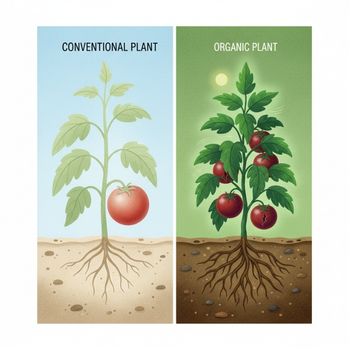Organic Tomato vs. Conventional Tomato: The Stress
Advantage That Boosts Nutrition🍅
Have you ever stood in the grocery aisle, held an Organic Tomato vs. Conventional Tomato, and asked yourself the big question: "Seriously, is organic food really better?"
I hear you. The price difference can be significant, and unless you have solid proof, it feels like you're just paying for a sticker. As a PhD Student focused on agriculture, and someone who grew up home gardening, I’ve spent years looking for that proof. And here’s what my research—and my hands-on experience—tells me: the difference isn't anecdotal. It's chemical.
The core reason the organic tomato is often nutritionally superior comes down to a predictable biological system that I call the "Stress Advantage." We are going to put on the lab coat, grab a trowel, and look inside the tomato to see the measurable differences in health-boosting antioxidants, vibrant flavor, and safety. I want you to feel empowered when you choose food for your family.
Quick Proof,
Up Front ✨
If you’re skeptical and need the facts first, here is what the expert data suggests about why the organic choice is a better investment:
- Antioxidant Armor: The organic growing method forces the tomato plant to work harder, activating its internal chemical defenses and reliably generating higher levels of beneficial antioxidants, especially Phenolic Compounds.
- Vibrant Flavor: Organic tomatoes are consistently higher in total acidity. This is the magic metric that creates a complex, intense flavor profile, banishing blandness from your meals.
- Safety Assurance: By avoiding synthetic fertilizers, organic tomatoes have a naturally lower load of worrisome contaminants, particularly nitrates and heavy metals like Cadmium.
Part 1: Why the Way a Tomato Grows Changes Everything
Growing up on a farm taught me a crucial lesson: plants are like athletes. If you give them too many shortcuts, they get soft. If you make them work for it, they build resilience. This philosophy explains the profound difference between the conventional and organic tomato.
Conventional Farming: The Fast-Food Approach 🍟

Conventional farming aims for maximum volume, fast. This is done by creating a perfectly pampered environment:
1. Synthetic Nitrogen Overload: Plants get easily accessible, synthetic nutrients, acting like high-octane fuel. This encourages the plant to prioritize getting big, fast (biomass accumulation).
2. No Challenges Allowed: Heavy use of pesticides and fungicides eliminates nearly all stress from bugs or diseases.
Here’s the rub: if the plant faces no threats, why would it spend energy building defenses? It won't. This results in the Dilution Effect. You get a big tomato, quickly, but the plant hasn't invested its resources into the costly, defensive, health-boosting molecules we want to eat. It’s nutritionally watered down.
Organic Farming: Resilience Training 💪
Organic growing prohibits those synthetic shortcuts. It relies on complex biological processes and rich, living soil. This creates an environment of managed difficulty:
- Slow Nutrient Delivery: Nutrients are cycled naturally through the soil microbes, creating subtle challenges for uptake.
- Low-Level Stress: The plant faces natural competition and low-level pressures from the environment (abiotic and biotic stress).
This environment compels the tomato to strengthen itself. It is forced to activate its internal chemical defense systems. The outcome? A phenomenon known as the Concentration Effect. It might be a slightly smaller harvest, but the fruit itself is packed with protective compounds.
The Plant’s Battle Plan: Secondary Metabolites (SMs)
This "Stress Advantage" is all about activating the Plant Defense Mechanism (PDM) inside the tomato.
As a PhD Student in agriculture, I study these tiny molecular heroes called Secondary Metabolites (SMs). Think of SMs as the plant’s homemade armor—they aren't needed for simple growth, but they are essential for survival. When the plant senses a nutrient shortage or a potential pest, it initiates a critical trade-off:
1. Defense Before Growth: The tomato immediately diverts its energy and resources away from rapid growth and redirects them toward making SMs, like powerful flavonoids (e.g., Quercetin) and carotenoids (Lycopene).
2. Concentrated Goodness: This process leads to the accelerated accumulation of protective compounds.
The slightly higher price tag on organic produce? It’s simply the economic reflection of the plant's internal investment in these concentrated therapeutic compounds. You are paying for the chemical resilience it developed in a healthier, more natural growing environment.
Part 2: The Data That Justifies the Cost 📊
So, does this resilience translate to better health for us? Yes, it does. The chemical armor the tomato builds to protect itself works beautifully as an antioxidant and anti-inflammatory agent inside the human body.
The Scientific Winner: Phenolic Compounds

If you want the most consistent, solid proof that organic is better, focus on phenolic compounds.
My research suggests this group of antioxidants offers the clearest argument. Studies show organic tomatoes reliably contain higher levels of specific phenolic compounds, including quercetin and kaempferol. These compounds are the plant’s essential chemical defense system, so their higher presence in organic fruit is the definitive scientific proof of the "Stress Advantage" theory in action.
In short, when you eat an organic tomato, you are getting a predictable, reliable dose of powerful antioxidants that help your body fight oxidative stress—a major factor in chronic diseases.
Why Some Nutrients Are Variable (And Why That's Okay)
You might have read conflicting reports about Lycopene and Vitamin C. That’s because these compounds are much trickier, and their levels are often inconsistent across studies:
- Lycopene: Some data show higher levels in organic tomatoes, but others show no difference. Why the variability? My hands-on experience shows that Lycopene is incredibly sensitive to temperature. If the climate gets too hot (over 30°C /86°C) during ripening, the chemical production pathway shuts down, regardless of the organic label.
- Vitamin C (Ascorbic Acid): Results here are chaotic—sometimes higher in organic, sometimes higher in conventional.6 This is because Vitamin C is highly fragile and degrades quickly after harvest due to temperature and storage time.
It is always better to focus on the stable, stress-induced compounds (phenolics) that are less susceptible to post-harvest drama.
Tomato Metrics: Organic vs. Conventional 📊🍅
| Nutritional Marker 🧪 | Organic Tomato Trend ✅ | Rationale/Impact (The Stress Advantage) 🧠 |
|---|---|---|
| Phenolic Compounds (e.g., Quercetin) | Consistently Higher ✨ | Direct response of the Plant Defense Mechanism (PDM) to environmental stress. This boosts the plant’s natural defenses, which function as powerful human antioxidants. |
| Total Acidity (The Flavor Metric) | Higher | Crucial for superior flavor complexity and vibrant taste profile, countering the blandness often found in conventional, fast-grown tomatoes. |
| Nitrate Content (Safety Risk) | Lower 📉 | Avoidance of synthetic, high-dose nitrogen fertilizers prevents excessive nitrate accumulation, offering a clear food safety advantage. |
| Heavy Metals (Cadmium) | Risk Mitigated 💪 | Rich soil organic matter inherent to organic farming naturally buffers (complexes) and limits the plant's uptake of harmful heavy metals. |
Part 3: The Consumer's Core Concerns—Safety and Flavor
The biochemical differences don't just benefit your health over the long term; they change the immediate experience of eating and provide crucial safety assurances.
Flavor: The Secret Ingredient is Acid
Have you ever wondered why a store-bought conventional tomato can taste so watery and bland, while a backyard organic one bursts with flavor? It's the acid.
Flavor quality is a dance between sugars and Total Acidity. The science consistently observes that organic tomatoes have higher total acidity. When that acid is balanced with the tomato's sugars, it creates a much more complex, vibrant, and intense flavor—the kind that makes a sauce sing. This heightened gustatory quality is a direct result of the organic growing process.
Mitigating Contaminants: The Safety Win 🛡️

You worry about protecting your family, and safety is a huge part of the organic justification.
1. The Nitrate Problem
One of the cleanest wins for organic is lower nitrate levels. Why? Conventional farming uses synthetic nitrogen to push rapid growth, which can lead to excessive nitrate accumulation in the fruit. By sticking to regulated, slow-release nitrogen cycling (compost, manure), organic farming naturally keeps that nitrate load lower, offering a direct, quantifiable health advantage.
2. The Heavy Metal Defense
Concerns about heavy metals, especially Cadmium (Cd), are valid, as exposure can cause kidney toxicity and cancer risk. Conventionally, Cadmium can enter the soil via certain fertilizers.
This is where the Farmer/Gardener in me steps in. Think of rich, organic soil as a sophisticated bank account. It's full of Soil Organic Matter (SOM). This SOM is a chemical buffer that literally grabs onto heavy metals like Cadmium, complexing them and reducing the plant's ability to suck them up. The mechanism of mitigation—the power of healthy soil—is an inherent safety superiority of the organic system.
A Note on Organic Tomato vs. GMO Tomato
I often get questions about the organic tomato vs GMO tomato debate. The key distinction here is focus. The core value of choosing organic isn't just avoiding genetic modification (which is prohibited in organic standards); it's actively choosing the cultivation system that results in the "Stress Advantage"—meaning higher nutritional density, better flavor, and verifiable reductions in contaminants.
Final Word: Making the Confident Choice
The comparison is clear: the organic tomato is a functionally superior food. It’s been chemically programmed for resilience by its environment, leading to predictably higher concentrations of powerful secondary metabolites that benefit our health.
For you, the high-intent consumer, this synthesis of data leads to clear, actionable guidance:
1. Justify the Cost with Proof: The premium price is justified by the predictable nutritional gain (phenolics) and the verifiable safety assurance (lower nitrates and Cadmium risk mitigation).
2. Cook with Organic: Because organic tomatoes show higher consistency, higher acidity, and higher antioxidant loads, they are the ideal base for any cooked product, like sauces, pastes, or ketchup, where concentrating the nutrients matters most.
3. Trust Your Taste: The flavor difference is real. The higher acidity translates directly into a more satisfying eating experience.
By choosing the organic tomato, you’re not just following a trend; you’re investing in a product backed by a powerful biological advantage.
Further Reading and Research
To continue your deep dive into the science of food quality:
- Read more on conventional versus organic tomato nutrient comparison
- Read more on the role of antioxidants in chronic diseases
- Read more on the Plant Defense Mechanism
